OPC UA | Cultivate the field of tomorrow
- Details
- Hits: 5700
If it's up to the makers of the OPC UA Standards are supposed to be proprietary network protocols soon be a thing of the past. More and more manufacturers of communication technology are already offering products with a manufacturer-independent OPC UA connection. Here you can find out what the current status of future technology is and which new products are coming onto the market.
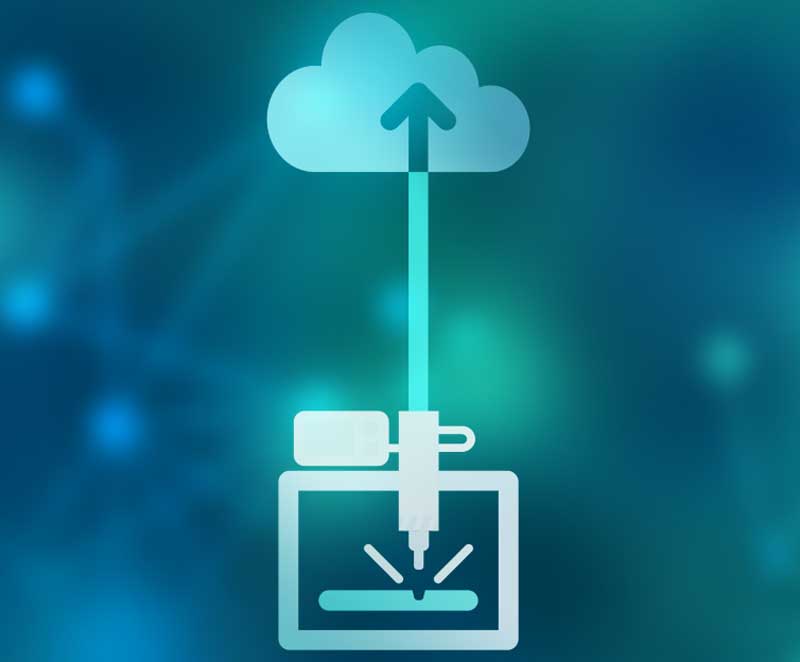
Contents
OPC UA – open to everyone
OPC UA (Open Platform Communications Unified Architecture) was developed to protocol diversity under the field buses send to history. This is becoming more and more necessary because the IIoT (Industrial Internet of Things) makes communication in the Industry 4.0 factory so complex that networks with hundreds of nodes in the field are the order of the day.
Machines and systems in the digital production hall with many different network components such as controllers, sensors, actuators, etc. have to be connected via the various Fieldbuses communicate. Gateways and switches ensure a smooth exchange, but the commissioning and maintenance costs increase enormously. And the more players work in the field, the more error-prone the overall construct becomes.
The open standard OPC UA, together with the also open network standard TSN (Time Sensitive Networking), will revolutionize fieldbus technology. With OPC UA over TSN, the proprietary fieldbuses will disappear, except for a few specific applications in which they can then still demonstrate their respective advantages.
Products with OPC UA connection
More and more manufacturers are offering their products with an OPC UA interface, making them more communication-capable. Here we present the new developments:
CAQ system

A simple integration into automated production processes and the interaction with the machine and system control are today indispensable prerequisites for the universal use of CAQ systems. The smooth integration of measurement technology and testing technology in the production and automation process is part of it SonicTC from RTE acoustics paved the way. The CAQ system is also prepared for the OPC UA client and LIN BUS (NI-Xnet, Babylin) communication.
encoder
 The Magnetic rotary encoder of the EAM580 and EAM360 series Baumer work particularly reliably and with high precision. The magnetic absolute rotary encoders work with an angular accuracy of ±0,15 degrees and thus enable exact positioning in the application. The OPC UA communication standard is also supported. This ensures a reaction-free and secure data exchange between different systems.
The Magnetic rotary encoder of the EAM580 and EAM360 series Baumer work particularly reliably and with high precision. The magnetic absolute rotary encoders work with an angular accuracy of ±0,15 degrees and thus enable exact positioning in the application. The OPC UA communication standard is also supported. This ensures a reaction-free and secure data exchange between different systems.
Edge Computing
 A more suitable solution for the OT / IT integration offer the new intelligent edge computing technologies. These technologies form an intermediate layer between the shop floor and the higher-level business systems. They offer a simple interface between the IT and the OT world as well as new options for where the data analysis takes place. The edge computing solution Melipc from Mitsubishi Electric offers this functionality and is OPC UA compatible.
A more suitable solution for the OT / IT integration offer the new intelligent edge computing technologies. These technologies form an intermediate layer between the shop floor and the higher-level business systems. They offer a simple interface between the IT and the OT world as well as new options for where the data analysis takes place. The edge computing solution Melipc from Mitsubishi Electric offers this functionality and is OPC UA compatible.
Gateway
 Insys Icom shows how the Industrial IoT is already changing with the new Smart IoT gateways for a variety of use cases from data acquisition to edge computing to professional remote maintenance. They support all common protocols required by the industry. The gateway makes machines and systems safe, cost-efficient and permanently fit for Industry 4.0. It integrates established industrial protocols such as OPC UA or Siemens S7/S5.
Insys Icom shows how the Industrial IoT is already changing with the new Smart IoT gateways for a variety of use cases from data acquisition to edge computing to professional remote maintenance. They support all common protocols required by the industry. The gateway makes machines and systems safe, cost-efficient and permanently fit for Industry 4.0. It integrates established industrial protocols such as OPC UA or Siemens S7/S5.
IO-Link master
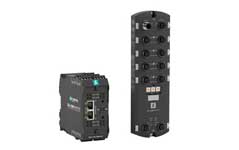 Pepperl + Fuchs can be the first company IO-Link master with an OPC UA interface, paving the way to consistent, transparent and seamless communication from the lowest field level to the cloud. The automation specialist has taken over the business of Comtrol Corporation, a pioneer in Ethernet-based industrial communication and a leading provider of IO-Link masters. This strengthens Peppel+Fuchs' position as a system provider in the field of IO-Link.
Pepperl + Fuchs can be the first company IO-Link master with an OPC UA interface, paving the way to consistent, transparent and seamless communication from the lowest field level to the cloud. The automation specialist has taken over the business of Comtrol Corporation, a pioneer in Ethernet-based industrial communication and a leading provider of IO-Link masters. This strengthens Peppel+Fuchs' position as a system provider in the field of IO-Link.
IO module
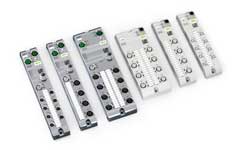 The I/O system field in protection class IP67 from Wago integrates fast, Ethernet-based fieldbuses such as Profinet, technologies such as OPC UA or web servers and, in the future, MQTT as a communication protocol, for example to connect to the cloud. In addition, the system is prepared for TSN, the key technology for consistent, flexible, powerful and secure networking. The Field I/O system supports all major Ethernet, fieldbus and industrial IoT standards.
The I/O system field in protection class IP67 from Wago integrates fast, Ethernet-based fieldbuses such as Profinet, technologies such as OPC UA or web servers and, in the future, MQTT as a communication protocol, for example to connect to the cloud. In addition, the system is prepared for TSN, the key technology for consistent, flexible, powerful and secure networking. The Field I/O system supports all major Ethernet, fieldbus and industrial IoT standards.
PLC control
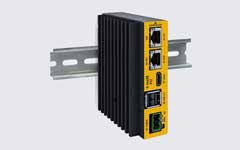 The B Maxx PLC mc from Baumüller controls motion control applications and, thanks to the manufacturer's comprehensive technology libraries, can be used quickly and easily for high-performance tasks in automation. With the Industry 4.0 variant B Maxx PLC IoT data can be collected directly on the machine, pre-processed and output to other end devices or the cloud. An OPC UA building block is also included, which ensures interoperability at machine level.
The B Maxx PLC mc from Baumüller controls motion control applications and, thanks to the manufacturer's comprehensive technology libraries, can be used quickly and easily for high-performance tasks in automation. With the Industry 4.0 variant B Maxx PLC IoT data can be collected directly on the machine, pre-processed and output to other end devices or the cloud. An OPC UA building block is also included, which ensures interoperability at machine level.
RFID interfaces
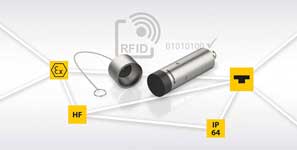 Turck presents new IIOT functions for its RFID interfaces with OPC UA Server. The IP67 RFID interface are equipped with a free firmware update for barrier-free communication in the Industrial Internet of Things (IIoT). This allows you to easily identify and track products, for example. With the AutoID Companion Specification V. 1.01, the OPC servers ensure smooth direct communication with MES, SPS, ERP or cloud systems.
Turck presents new IIOT functions for its RFID interfaces with OPC UA Server. The IP67 RFID interface are equipped with a free firmware update for barrier-free communication in the Industrial Internet of Things (IIoT). This allows you to easily identify and track products, for example. With the AutoID Companion Specification V. 1.01, the OPC servers ensure smooth direct communication with MES, SPS, ERP or cloud systems.
safety brake
With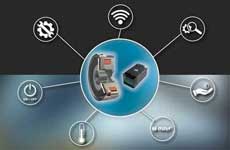 an additional board and a custom one Communication-Interface such as Ethernet, WLAN, OPC UA or optical can reduce the switching times of safety brakes from Mayr be monitored. From the brake monitoring conclusions can be drawn about the wear. Error analysis and optimization are also possible if other system components are compared in terms of holding current, temperature, resistance, coil voltage, temperature, resistance or power.
an additional board and a custom one Communication-Interface such as Ethernet, WLAN, OPC UA or optical can reduce the switching times of safety brakes from Mayr be monitored. From the brake monitoring conclusions can be drawn about the wear. Error analysis and optimization are also possible if other system components are compared in terms of holding current, temperature, resistance, coil voltage, temperature, resistance or power.
Safety control
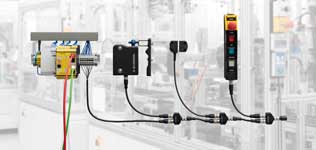 The Schmersal Group poses with the safety controller Protect PSC1 with an integrated OPC UA server, a new solution suitable for Industry 4.0. The connection of the PSC1 to the industrial machine-to-machine communication protocol enables extensive information from the manufacturer's products to be included in a manufacturer-independent data exchange in the future. In addition, they can provide maintenance information about the machines and systems.
The Schmersal Group poses with the safety controller Protect PSC1 with an integrated OPC UA server, a new solution suitable for Industry 4.0. The connection of the PSC1 to the industrial machine-to-machine communication protocol enables extensive information from the manufacturer's products to be included in a manufacturer-independent data exchange in the future. In addition, they can provide maintenance information about the machines and systems.
temperature control unit
 In the focus of Regloplas is the networking of the temperature control units and their integration into the data exchange of industrial production. The latest generation of temperature control units can be networked with injection molding and other plastics machines via the OPC UA communication protocol and connected to the central control, PPC, MES or ERP systems of the plastics production via OPC UA.
In the focus of Regloplas is the networking of the temperature control units and their integration into the data exchange of industrial production. The latest generation of temperature control units can be networked with injection molding and other plastics machines via the OPC UA communication protocol and connected to the central control, PPC, MES or ERP systems of the plastics production via OPC UA.
These are the requirements for one continuous data exchange in the highly automated, digitized Plasticprocessing created. The integration applies not only to needs-based control, but also to visualization and data analysis: A central dashboard creates transparency in the process. It allows e.g. B. the adjustment of parameters to the current requirements and visualizes all relevant process data.
Each temperature control unit has one own OPC client server and is therefore fully capable of integration, e.g. B. in the PPS, MES or ERP-Systems of the user. In addition, the standardized interface is compatible with other standard industry protocols and bus systems such as Ethernet/IP, Profibus, Profinet, Modbus, Powerlink. Communication can also take place across locations via the cloud.
News about OPC UA
The actors involved in the OPC UA standard development work in working groups, organizations or manufacturer-independent in companies with the advancement of technology. How? The following articles show this:
PI announces OPC UA Companion specification for Profinet
02.06.2020/XNUMX/XNUMX | Profibus + Profinet International announces the first OPC UA Companion specification for Profinet. It describes a standardized OPC UA object model for the devices of the Communications standards. This means that these Profinet devices from a wide variety of manufacturers can use uniform device data, e.g. B. transferred to asset management systems.
Standardization makes it easier to collect information across manufacturers. According to PI, this is just the beginning of PI's strategy for vertical integration.
Many Industry 4.0 applications are based on data from the shop floor in IT systems and in the operating phase of a system Cloud to be transmitted where they are evaluated. In the simplest case, this is device information such as the serial number or firmware of a device. If network or device diagnostic data can be determined, it can go much further.
Reduce effort and costs for data acquisition
This can be used to create maintenance and diagnostic plans or to derive availability statements. PI wants one open standard define for Profinet devices. It is intended to define a wide range of information in standardized object models that manufacturers can easily integrate into their devices and that plant operators and system integrators can use. This also reduces the effort and costs for data collection.
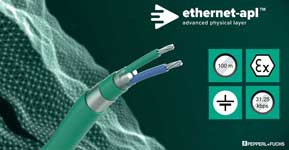 Ethernet APL | Current status, applications and implementation
Ethernet APL | Current status, applications and implementation
It does not matter during implementation whether the OPC UA server is located directly on the device or a layered edge Gateway or a controller aggregates the data for several Profinet devices. The user always receives a homogeneous representation of the information. Profinet benefits from the fundamental property that, in addition to real-time traffic, other TCP / IP channels can be operated in parallel.
Technical work on OPC UA Safety completed
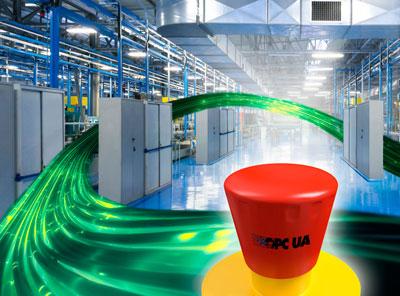 16.12.2019 | Already at an early stage Profibus + Profinet International (PI) for OPC UA as an open, manufacturer-independent standard for machine-to-machine communication. However, to round off the technology, a standard for fail-safe communication at this level has so far been lacking. This solves the specification "OPC Unified Architecture Part 15: Safety", a joint development of the OPC Foundation and PI. The technical work is now complete.
16.12.2019 | Already at an early stage Profibus + Profinet International (PI) for OPC UA as an open, manufacturer-independent standard for machine-to-machine communication. However, to round off the technology, a standard for fail-safe communication at this level has so far been lacking. This solves the specification "OPC Unified Architecture Part 15: Safety", a joint development of the OPC Foundation and PI. The technical work is now complete.
Since Introduction of fieldbuses the modularization of plants was a driving force behind the technology. Individual machines could thus be developed independently of one another and only put into operation together on the system. With OPC UA, a technology is now in the starting blocks that is independent of the ones used fieldbuscross-manufacturer networking between the machines within the machine.
However, up to now, OPC UA has not had the option of transferring fail-safe data, as one is used to from fieldbuses with Profisafe. Safety functions therefore had to be carried out conventionally with direct cabling or couplers. This increases the effort and reduces flexibility.
The technical work on OPC UA Safety is now complete. The next step is the development of a test specification and a software tool for the automatic test. This also includes the establishment of a certification and acceptance procedure analogous to Profisafe. This is the prerequisite for a quick and easy safety certification of products that implement OPC UA Safety.
Case studies for the demonstration
On the other hand, case studies are created to demonstrate the new features of OPC UA Safety to demonstrate. This includes the simplified management of secure addresses for series machines and the option of being able to communicate with different partners via one and the same connection during runtime. Furthermore, an OPC UA mapper for Pub/Sub is specified in order to be able to implement security functions with high demands on the response time.
This first specification forms the basis for more extensive information models Next, the working group has set itself the goal of modeling energy management data in OPC UA on the basis of Profienergy. Further requirements are already in the clarification phase. The working groups also work closely together on overarching OPC specifications such as Base Network Information Model and Device Integration.
A communication standard for Auto ID
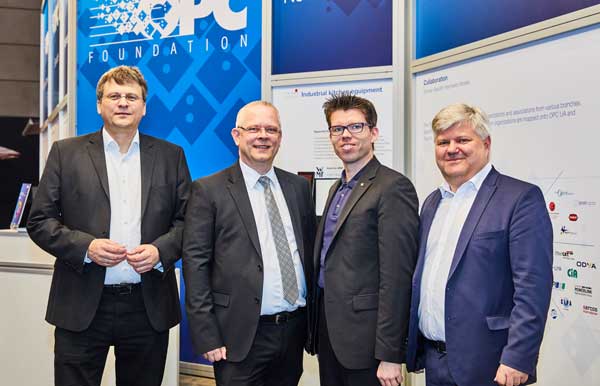 30.07.2019/2016/XNUMX | XNUMX has the AIM-D Association in cooperation with the OPC Foundation released a new communication standard for Auto ID devices. The last SPS IPC Drives in Nuremberg showed that this standard is accepted by many device manufacturers and their users across the entire Auto ID spectrum. Harting was in the boat right from the start.
30.07.2019/2016/XNUMX | XNUMX has the AIM-D Association in cooperation with the OPC Foundation released a new communication standard for Auto ID devices. The last SPS IPC Drives in Nuremberg showed that this standard is accepted by many device manufacturers and their users across the entire Auto ID spectrum. Harting was in the boat right from the start.
Motivated by Siemens and Harting the AIM working group for system integration decided in 2014 to define a new, promising, technology- and manufacturer-independent communication standard for the Auto ID (automatic identification and data acquisition) industry. Until now, many devices communicated via proprietary interfaces. In addition, different communication standards often applied to different technologies. In other words, whether barcode or UHF, RFID also had an influence on the programming of the communication interface of the software to be connected. These circumstances had grown historically.
Auto ID as a base technology for 4.0 industry
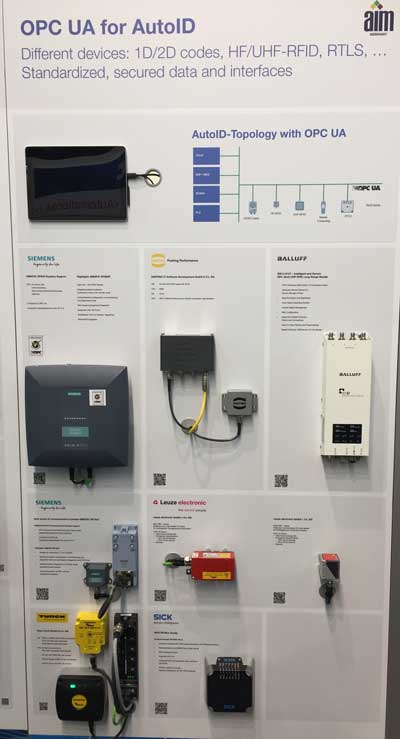 Containers, printed circuit boards, car bodies, hospital beds and much more can now be identified automatically thanks to Auto ID technology - usually completely passively without any maintenance work on the object. With UHF RFID (also called RAIN RFID) the object itself is given a memory. Information such as the date of manufacture and the firmware version of a printed circuit board can be stored directly, in this example on the printed circuit board, without a power supply, can be called up wirelessly or can be updated.
Containers, printed circuit boards, car bodies, hospital beds and much more can now be identified automatically thanks to Auto ID technology - usually completely passively without any maintenance work on the object. With UHF RFID (also called RAIN RFID) the object itself is given a memory. Information such as the date of manufacture and the firmware version of a printed circuit board can be stored directly, in this example on the printed circuit board, without a power supply, can be called up wirelessly or can be updated.
The Auto ID technology is now a self-evident tool for creating a total solution, e.g. B. to realize an automatically working warehouse logistics center. Communication barriers are undesirable. Which Auto ID technology is used for which purpose should also be decided by the application and not by the communication interface of the Auto ID device. In addition, classic communication structures such as the automation pyramid are broken up. Today, an RFID reader communicates directly with an ERP system as well as with a PLC on the production line.
Motivated by these ideas and requirements, the AIM working group to define a communication interface based on OPC UA. OPC UA is one of the standards for the implementation of modern communication architectures and is also listed in the RAMI specifications of the federal government on the subject of Industry 4.0. In addition, OPC UA is already supported by many PLCs and software systems. Communication with the machine and the database system in the cloud is so easy to implement. OPC UA is the communication standard of the automation industry. There is almost no provider for this industry and almost no machine manufacturer who does not already offer an OPC UA interface today.
Thanks object-oriented structure OPC UA is very well suited to developing a common communication standard for a wide variety of Auto ID technologies. Similarities such as a scan method for the simple recognition of an ID can be defined in higher-level classes. Specific characteristics can be implemented in classes derived from this for the individual Auto ID technologies. With this mechanism, manufacturer-specific extensions based on the standard can also be entered without questioning the common basic functionality.
Safety instaled right away
Communication security is also an important issue. Isolated communication systems are also becoming increasingly rare in production and logistics. As already mentioned, the vertical and horizontal integration of Auto ID systems is crucial today in order to create an overall solution. OPC UA already offers various integrated options security mechanisms.
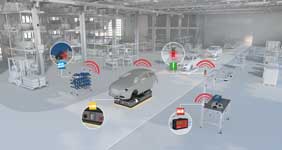 Energy-efficient radio network for the Industry 4.0 factory
Energy-efficient radio network for the Industry 4.0 factory
This was also tested by the Federal Office for Information Security (BSI). The BSI has confirmed that OPC UA already offers integral mechanisms for implementing secure data communication. The BSI says: "OPC UA was developed under security aspects and does not contain any systematic security gaps". This aspect should not be neglected for Auto ID systems. After all, based on the data communicated by the AutoID system, complete machines and processes work largely autonomously.
The members of the AIM association generally considered the issue of security to be important, not just in terms of communication with PLCs or computer systems. AIM Germany therefore has its own working group in 2018 AutoID+Security founded. This working group develops recommendations for action on how to use Auto ID technology safely.
In 2016, AIM Germany presented the new OPC Unified Architecture for Auto ID Companion Specification at the Hannover Messe before. The first RAIN RFID devices available on the market from Siemens and Harting were in one demo application demonstrated at the booth of the OPC Foundation. Direct communication, for example to the Microsoft Azure Cloud, is not a problem. The interface specification is freely available to everyone on request at info@aim-d.de. In this way, all PLCs and backend systems can integrate this interface directly.
OPC UA has gained even more importance since 2016. The accession of Volkswagen Groups in the OPC Foundation in 2018 show that one of the key sectors in Germany and Europe, the automotive industry, also considers OPC UA important. On May 21, 2019, the Automation Initiative of German Automobile Manufacturers (AIDA), together with the Association of German Machine and Plant Manufacturers (VDMA), in cooperation with the OPC Foundation, is organizing an OPC UA information day for automotive suppliers at Volkswagen in Wolfsburg. This also shows that users of Auto ID technology are demanding OPC UA.
Auto ID devices with OPC UA interface
The OPC Unified Architecture for Auto ID Companion Specification published in 2016 has now been integrated into the devices of many Auto ID manufacturers. As could be seen at the OPC Foundation booth at SPS IPC Drives in November 2018, barcode, HF and UHF devices with an OPC UA interface are now available. We currently have different Auto ID technologies, but a common communication standard. A uniform, secure data communication to a wide variety of devices from different manufacturers is thus a reality based on OPC UA, the future-proof communication standard in the automation industry.
 Scada systems today? The tried and tested over time
Scada systems today? The tried and tested over time
Of course, the Auto ID devices of the individual manufacturers continue to differ. The devices have sufficient differentiation options. Only the exchange of data is standardized. This simplifies the integration of Auto ID technology. Thanks to inbuild security When used correctly, the security of communication increases. This accelerates the expansion of automation towards Industry 4.0.
Future work of the working group
 However, the system integration working group did not end its work in 2016. The participants are constantly working on expanding and improving the interface specification. The tasks here are varied. A core topic is the simplification of the interface for - from an Auto ID point of view - simpler application scenarios. This should accelerate implementation and interface integration and remove unnecessary hurdles. In the future, a simple scanning of an individual object can be effected purely via variables. Function calls are no longer required. The implementation effort is reduced to a minimum.
However, the system integration working group did not end its work in 2016. The participants are constantly working on expanding and improving the interface specification. The tasks here are varied. A core topic is the simplification of the interface for - from an Auto ID point of view - simpler application scenarios. This should accelerate implementation and interface integration and remove unnecessary hurdles. In the future, a simple scanning of an individual object can be effected purely via variables. Function calls are no longer required. The implementation effort is reduced to a minimum.
Another important issue is the Integration of Sensordata. In particular, the RAIN RFID technology is being used more and more to transmit sensor values. In this way, objects can be clearly identified, additional data can be read out and the current object status can be queried. Information on whether the transmission is too hot, the body is damp or the container is securely locked can also be queried directly. Often even without batteries - i.e. passively and without additional maintenance work. The individual technologies are merging more and more. Classic sensor technology and Auto ID are growing together.
AIM Germany also took up this aspect in an additional working group "RFID+Sensors" in 2018. The results and recommendations of this working group are of course also taken into account when expanding the OPC UA-based interface. There is also an international exchange via the RAIN or AIM North America association.
The latest release of the OPC Unified Architecture for Auto ID Companion Specification by AIM Germany in cooperation with the OPC Foundation has been presented at the Hannover Messe 2019. First results of the above-mentioned work packages are already included here.
OPC UA TSN establishment is progressing
28.11.2017/XNUMX/XNUMX | Excerpts from the OPC UA TSN Pressekonferenz: representatives of ABB, Hirschmann, Bosch Rexroth, B+R, Cisco, Hilscher, National Instruments, Phoenix Contact, Schneider Electric, SEW-Eurodrive, TTTech and the international consortia Avnu Alliance, the Industrial Internet Consortium and the OPC Foundation explained at a joint press conference at the SPS IPC Drives in Nuremberg their role in achieving the common goal of ensuring the interoperability of industrial devices based on OPC UA over Time Sensitive Networking (TSN).
OPC UA basics
What does OPC UA stand for?
OPC UA is a communication protocol for industrial automation, which enables secure, platform-independent and manufacturer-independent data transmission. It can transmit information about machine status, measurement data, process parameters and other industry-related data. The data transmission is semantic and no longer dimensionless. Thanks to its open architecture, the protocol offers seamless networking of devices from different manufacturers. OPC UA is therefore of crucial importance for Industry 4.0.
What is TSN?
Time-Sensitive Networking (TSN) is a set of standards developed by the IEEE 802.1 working group, which aims to provide deterministic messages on Ethernet-based networks. TSN enables reliable real-time communication via Ethernet and ensures that data packets are transmitted within a specified time window. This is particularly important in Industry 4.0 applications, Automobilecommunications and other areas where real-time data transmission and synchronization are crucial. TSN employs a number of mechanisms to ensure this real-time communication such as time synchronization, traffic scheduling, quality of service (QoS) and seamless redundancy.
What does OPC UA over TSN mean?
OPC UA over TSN combines the capabilities of OPC UA and TSN into a unified communication solution for industrial automation. If OPC UA is implemented via TSN, OPC UA becomes the data model and the Communication layer, while TSN as transport medium used for real-time data transmission. That means: interoperability, real-time communication, security and future security. Overall, OPC UA over TSN significantly simplifies the industrial communication landscape and paves the way for a uniform, secure and reliable communication system for the factory of the future.

Angela Struck is editor-in-chief of the development scout and freelance journalist as well as managing director of Presse Service Büro GbR in Ried.
